Species |
Young |
Adult |
|
Male |
Female |
||
Chicken |
Chick |
Cock |
Hen |
Duck |
Duckling |
Drake |
Duck |
Turkey |
Poult |
Tom |
Hen |
Quail |
Chick |
Cock |
Hen |
Guinea fowl |
Keet |
Cock |
Hen |
Goose |
Goosling |
Gander |
Goose |
Pigeon |
Squab |
Pigeon |
Pigeon |
Swan |
Cygnet |
Swan |
Swan |
Incubation period, Chromosome numbers and age at sexual maturity of different species of poultry
S.No |
Species |
Incubation period (days) |
Chromosome number (pairs) |
Age at sexual maturity (weeks) |
1. |
Chicken |
21 |
39 |
18-20 |
2. |
Duck |
28 |
40 |
28-30 |
3. |
Muscovy duck |
33-35 |
40 |
28-30 |
4. |
Goose |
28-32 |
40 |
28-30 |
5. |
Guinea fowl |
27-28 |
39 |
28-32 |
6. |
Turkey |
28 |
40 |
28-30 |
7. |
Quail |
17-18 |
39 |
6-7 |
8. |
Pigeon |
18 |
39 |
10-12 |
9. |
Ostrich |
42 |
40 |
52 |
10 |
Emu |
52-55 |
40 |
52 |
BREEDS OF CHICKEN
Chicken breeds are usually classified based on four major official classes:
Incubation period, Chromosome numbers and age at sexual maturity of different species of poultry
Class |
American |
Asiatic |
English |
Mediterrane an |
Shank |
Clean |
Feathered |
Clean |
Clean |
Skin colour |
Yellow |
Yellow |
White |
Yellow or white |
Earlobe colour |
Red |
Red |
Red |
White |
Purpose |
Dual |
Meat |
Dual |
Egg |
Size |
Medium |
Massive |
Medium |
Small |
Shell colour |
Brown |
Brown |
Brown |
White |
Examples |
1) Rhode Island Red |
1) Brahma |
1) Cornish |
1) Leghorn |
Chicken may also classified based on their utility as,
1) Egg type - Eg. White Leghorn, Minorca, Ancona
2) Meat type - Eg. Cornish, Plymouth rock, Brahma
3) Dual purpose - Eg. Rhode Island Red, New Hampshire
4) Game bird - Eg. Aseel
5) Fancy variety - Eg. Silky, frizzled, bantams
6) Desi type - Eg. Kadaknath, Naked neck, chittagong.
There are only four pure Indian breeds of chicken are available. They are, Aseel, Chittagong, Busra and Kadaknath.
1. Aseel:
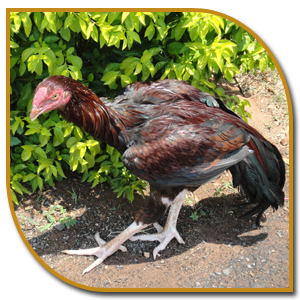 |
 |
2. Chittagong:
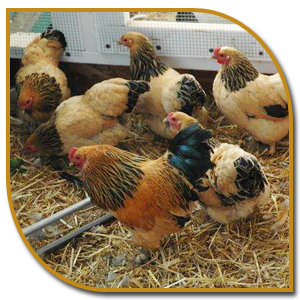 |
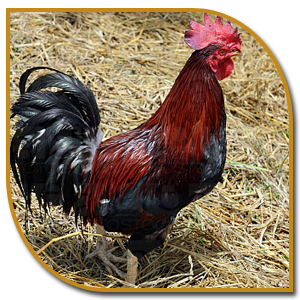 |
3. Kadaknath:
 |
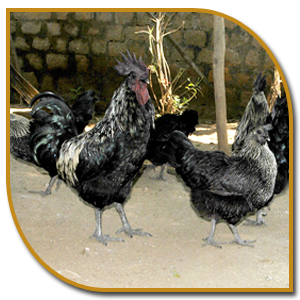 |
4. Busra:
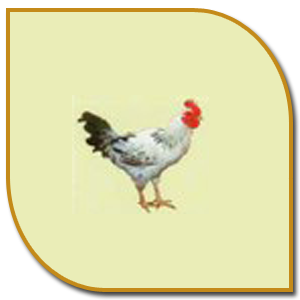 |
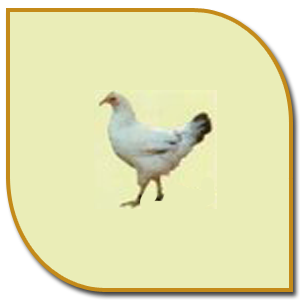 |
Note:
Hybrids of chicken
These are incrossbreds of chicken, produced by 2-way, 3-way or 4-way crossing of inbred pure lines. They are the actual commercial-type of chicken used for egg or meat production since they are high laying or fast growing. These birds possess high degree of heterosis or hybrid vigour.
1) Common egg-type hybrid chicken (layers):
BV-300, ISA Babcock, Bovans, Euribrid, Hyline, Dekalb, Lohmann, Keystone, H&N nick chick etc.
2) Common meat-type hybrid chicken (Broilers):
Cobb, Ross, Hybro, Hubbard, Starbro, Avian-34, Anak-2000, Arbor acres, Hub chicks, Peterson etc.
Different Comb types of chicken
Comb is a fleshy protuberance on top of the fowl’s head, generally red in colour and of various types and shapes. The type of comb is usually a breed or variety characteristic. The comb type is the result of gene interaction but the comb size is associated with gonadal development and intensity of light under which they are grown. Some of the types of combs are,
1) Single comb:
A comb which when viewed from the front, is narrow and having spikes in line behind each other. It consists of a blade surmounted by spikes. The lower solid portion being the blade and the spaces between the spikes are called serrations. It differs in size, shape and number. The number of serrations varies according to breeds. The White Leghorn has 5 spikes and RIR and Minorca have 6 spikes. The gene for single comb is recessive to the gene for Rose and Pea comb.
2) Pea comb
It is a triple comb resembling three small single combs joined together at the base and rear but distinctly divided. The middle one is being the highest than others. It is very well seen on the head of a well-bred Brahma.
3) Rose comb
It is a broad comb, near flat on top, covered with small regular points and finishing with a spike. It varies in length and width according to breed.
Eg. Wyandotte.
4) Strawberry or Walnut comb
This type of comb is somewhat resembling half a strawberry, with the round part of the fruit uppermost. It is relatively small in size and has irregular grooves on the surface. When rose comb and pea comb are crossed, all the progeny will have walnut comb due to the complementary effect of ‘R’ and ‘P’ genes.
Eg. Malays breed
5) V- Shaped comb or Duplex comb or Horn comb
It resembles horns, but generally similar to the letter ‘V’. The comb starts just above the beak and from it branches into two spikes, thick at the base and tapered at the end. Eg. Houdans breed.
6) Cushion comb
It is almost circular cushion of flesh, with a number of small prominences over it. It is having a slight furrow transversely across the middle. Eg. Silkie breed.
7) Cup comb
This comb is somewhat resembling a tea-cup with edges spiked. Eg. Sicilian Buttercup breed.
Need for handling of chicken
Handling of chicken
First, bird is to be caught from the flock in case of deep-litter system or to be taken out from the cage before it is handled for any of the above-operations.
While catching bird on deep-litter, it is to be caught either by putting catching hooks to the leg or simply by grabbing the legs with fingers. Birds should never be caught by neck or feathers, which can put birds under severe stress or discomfort. For holding bird for some time before starting of actual operation, it can be held at wings or its movement can be restricted or stopped by entangling their wings to each other at the base.
While taking out bird from cage, head with neck should be taken out first by holding body of birds in both the hands with closure of wings to facilitate easy removal of bird from cage, without causing any injury to bird. The same procedure is followed while putting bird in cage i.e. head is entered first; followed by body.
To hold the bird for examination, abdomen of bird should rest on palm of one hand by grabbing two legs of bird between fingers, facing head of bird towards examiner; keeping one hand free for examination. The examination is done by gentle handling with minimum stress to prevent struggling.
The yolk is not the true reproductive cell, but a source of food material from which the minute cell (blastoderm) and its resultant embryo partially sustain their growth. When the pullet reaches sexual maturity, the ovary and the oviduct undergo many changes. About 11 days before laying first egg, a sequence of hormonal changes occur. The follicle-stimulating hormone (FSH) produced by the anterior pituitary gland causes the ovarian follicles to increase in size. In turn, the active ovary begins to generate hormones, viz. estrogen, progesterone, and testosterone. Higher blood plasma levels of estrogen initiate development of the medullary bone, stimulate yolk protein and lipid formation by the liver and increase the size of the oviduct, enabling it to produce albumen proteins, shell membranes, calcium carbonate for shell formation and cuticle. The yolk material is laid down adjacent to the germinal disc that continues to remain on the surface of the globular yolk mass. About 10 days are required for an individual yolk to mature.
Deposits of yolk material are very slow at first and light in colour. The colour present in the yolk is xanthophylls, a carotenoid pigment derived from the diet. The pigment is transferred first to the bloodstream, then quickly to the yolk. More carotenoids are deposited when the extending out from the yolk, are formed as the egg is rotated in the lower portions of the oviduct. Twisted in opposite directions, the chalazae tend to keep the yolk centered in the egg after it is laid.
Shell membrane formation
The shell membranes are added to the egg in the isthmus. These membranes are made up of many interlacing fibres and are somewhat permeable to both water and air. Two membranes are formed, an inner and outer shell membranes. These are rather loose-fitting membranes when first formed. Water and salts are added to the egg in the uterus to ‘plump out’ the egg into its final shape. The outer shell membrane is about 3 times as thick as the inner one. The outer membrane is about 0.05 mm thick, and the inner is only 0.015 mm. The membranes normally adhere to each other except at the large end of the egg, where they are separated to form the air cell. The air cell is quite small when the egg is first laid but progressively increases in size as the egg cools and as water later escapes from the contents by evaporation through the membranes and the shell.
Egg shell formation
The egg remains longest in the uterus or shell gland, where the eggshell is formed, which requires 19 to 20 hours. The shell is made up of almost entirely of calcium carbonate deposited on an organic matrix consisting of protein and mucopolysaccharide. The shell membranes intimately bound the shell on the inside. The shell is embedded in the membranes by a structure known as the basal cap, a portion of cone layer, which is the innermost part of the shell. The major portion of the shell is made up of a palisade or column layer that is penetrated by numerous pores extending through the shell. The final layer of the shell is known as the cuticle, an organic material covering the surface of the egg. The cuticle seals the pores and is useful in reducing moisture losses and in preventing bacterial penetration of the eggshell.
Laying of the Egg
Eggs are normally formed with small end first as they move down the oviduct. If the hen is not frightened, the egg will rotate horizontally just prior to oviposition (the act of laying egg) and will be expelled large end first. However, if something disturbs the bird prior to rotation, the egg will be laid quickly and forced through the vent small end first.
S. |
Part of the oviduct |
Functions |
Duration of developing egg stays |
Length (cm) |
1 |
Infundibulum |
Picking and engulfing the yolk |
15 minutes |
9 |
2 |
Magnum |
Secretion of thin and thick albumen |
3 hours |
33 |
3 |
Isthmus |
Formation of shell membranes |
1 hour & 15 minutes |
10 |
4 |
Uterus |
Formation of shell |
18 to 21 hours (Average 20 hours) |
10 |
5 |
Vagina |
Oviposition |
2 to 5 minutes |
6 |
Total |
24 hours & 35 minutes |
68 |
||
Structure of Egg
The egg has four main parts namely (1) yolk, (2) Albumen, (3) Shell membranes and (4) Shell.
1) Yolk:
The yolk is normally held centrally by the chalazae. The two chalazae are attached to the chalaziferous layer of albumen around the yolk and one to each pole of the egg and anchored in the dense albumenous sac or outer thick albumen. The yolk is enclosed in a colourless membrane called vitalline membrane. Latebra is in the centre of the yolk, which is a small and nearly circular score of light coloured fluid, which does not completely harden on boiling. The yolk is 30 to 33% of the total weight of an egg. During the formation of yolk, concentric rings of yolk material are laid down, in alternate light and dark yellow layers, one layer for each day of yolk formation.
Germinal disc is the reproductive cell present on the surface of the yolk. If fertilized the germ cell is then called as blastoderm and if not it is called as blastodisc.
2) Albumen:
Albumen or white of the egg surrounds the yolk. There are four layers of albumen amounting to approximately 57% of the total volume of the egg.
The albumen is a protection for the blastoderm. It keeps blastoderm from coming in contact with the shell and lessens the force of jarring. Another function of the albumen is to prevent the entrance of bacteria to the yolk or germ cell.
3) Shell membranes:
There are two shell membranes: the inner and outer. The outer is attached to the shell and the inner is loosely attached to the outer albumen layer and encloses the egg contents. The shell membranes allow transmission of gases to and from the egg contents.
4) Shell:
Shell consists of the following:
The shell colour is characteristic of breed that may be white, brown or green. Brown colour is due to the presence of a pigment called Oophorphyrin. Biliverdin pigment is responsible for the Green Colour of eggs produced by Auracana breeds.
Physical composition of egg of various species
|
Bird |
|||
Chicken |
J. quail |
Turkey |
Duck |
|
Egg weight (g) |
57 |
12 |
85 |
80 |
Yolk (%) |
30 |
32 |
32 |
35 |
Albumen (%) |
60 |
48 |
56 |
53 |
Shell (%) |
10 |
20 |
12 |
12 |
Chemical composition of chicken egg
Components |
Whole egg |
White |
Yolk |
Shell and shell membrane |
100% |
56-61% |
27-32% |
8-11% |
|
Water |
65.0 |
87.0 |
48.0 |
2.0 |
Protein |
12.0 |
11.0 |
17.5 |
4.5 |
Fat |
11.0 |
0.2 |
32.5 |
- |
Carbohydrate |
1.0 |
1.0 |
1.0 |
- |
Ash |
11.0 |
0.8 |
1.0 |
93.5 |
Total |
100.0 |
100.0 |
100.0 |
100.0 |
Egg Proteins
Albumen Proteins |
|||
Protein |
% |
Functions / Characteristics |
|
1. |
Ovalbumin |
54.00 |
Protease inhibitor |
2. |
Ovotransferrin (Conalbumin) |
12.00 |
Binds metals (iron) |
3. |
Ovomucoid |
11.00 |
Inhibits trypsin |
4. |
Ovoglobulins |
8.00 |
Foaming agent |
5. |
Ovomucin |
3.50 |
Viscosity builder |
6. |
Lysozyme |
3.40 |
Destroys bacteria |
7. |
Ovoinhibitor |
1.50 |
Serine proteases inhibitor |
8. |
Ovoflavoprotein |
0.80 |
Binds riboflavin |
9. |
Ovomacroglobulin |
0.50 |
Strongly antigenic |
10. |
Avidin |
0.05 |
Binds biotin |
11. |
Cystatin |
0.05 |
Protease inhibitor |
Yolk Proteins |
|||
Protein |
% |
Functions / Characteristics |
|
1. |
Ovovitelline |
75.00 |
Phosphorus containing protein |
2. |
Ovolivetin |
25.00 |
Sulphur containing protein |
Egg Lipids
Lipids |
% |
|
1. |
Triglycerides |
72.00 |
2. |
Phospholipids |
23.00 |
3. |
Cholesterol and other sterols |
5.00 |
Egg Carbohydrates
The carbohydrate content of egg is very low (1%). Of which, 75% is found in albumen and 25% in yolk. The half of the carbohydrates present in albumen is as free glucose and half as glycoproteins. In dried egg products, glucose interacts with other egg components to produce off-colours and off-flavours during storage. In order to avoid this problem, the glucose is eliminated by enzymatic digestion just before the drying process
Chicken egg without the shell (Shell egg weight-60.9g) |
|||||
Vitamin |
Units |
Whole liquid |
White |
Yolk |
|
1. |
A |
IU |
260.00 |
0 |
260.00 |
2. |
D |
IU |
27.00 |
0 |
27.00 |
3. |
E |
mg |
0.88 |
0 |
0.88 |
4. |
B12 |
mg |
0.48 |
0 |
0.48 |
5. |
Biotin |
mg |
11.00 |
2.62 |
8.38 |
6. |
Choline |
mg |
237.00 |
0.50 |
236.50 |
7. |
Folic acid |
mg |
0.03 |
0.01 |
0.03 |
8. |
Inositol |
mg |
5.90 |
1.54 |
4.36 |
9. |
Niacin |
mg |
0.05 |
0.04 |
0.01 |
10. |
Pantothenic acid |
mg |
0.81 |
0.09 |
0.72 |
11. |
Pyridoxine |
mg |
0.07 |
0.01 |
0.06 |
12. |
Riboflavin |
mg |
0.18 |
0.11 |
0.07 |
13. |
Thiamine |
mg |
0.05 |
0.01 |
0.05 |
* Vitamin C is absent in egg |
|||||
Chicken egg without the shell (Shell egg weight-60.9g) |
||||
Mineral (in mg) |
Whole liquid |
White |
Yolk |
|
1. |
Calcium |
29.00 |
3.80 |
25.20 |
2. |
Chlorine |
96.00 |
66.10 |
29.90 |
3. |
Copper |
0.03 |
0.01 |
0.02 |
4. |
Iodine |
0.03 |
0.01 |
0.03 |
5. |
Iron |
1.08 |
0.01 |
1.05 |
6. |
Magnesium |
6.30 |
4.15 |
2.15 |
7. |
Manganese |
0.021 |
0.01 |
0.02 |
8. |
Phosphorus |
110.00 |
8.00 |
102.00 |
9. |
Potassium |
74.00 |
57.00 |
17.00 |
10. |
Sodium |
72.00 |
63.00 |
9.00 |
11. |
Sulphur |
90.00 |
62.00 |
28.00 |
12. |
Zinc |
0.71 |
0.05 |
0.66 |
Pigments of Chicken Egg
Egg pigments are distributed in all parts of egg. Yolk contains high quantity of pigments. The yolk pigments are classified based on its solubility as lipochrome (fat soluble) and lyochrome (water soluble). Lipochromes are group of carotenoids (carotene and xanthophylls). The albumen contains one pigment called ovoflavin. Ooporphyrin and oocyan are responsible for the shell colour
CHEMICAL COMPOSITION OF POULTRY MEAT (per 100g of edible meat)
Nutrient |
Chicken |
Turkey |
Goose |
Duck |
J. quail |
Water (%) |
66 |
70 |
50 |
49 |
73 |
Protein (%) |
18 |
20 |
16 |
11 |
20 |
Fat (%) |
15 |
8 |
34 |
34 |
5 |
Carbohydrates (%) |
Traces |
Traces |
Traces |
Traces |
Traces |
Ash (Minerals) (%) |
0.79 |
0.88 |
0.87 |
0.68 |
1.40 |
Energy (Kcal / 100g) |
215 |
160 |
371 |
404 |
190 |
Cholesterol (mg / 100g) |
75 |
68 |
76 |
80 |
62 |
Vitamin |
Units |
mg/100g edible meat |
|
1. |
A |
IU |
41 |
2. |
C |
mg |
1.6 |
3. |
Thiamine |
mg |
0.06 |
4. |
Riboflavin |
mg |
0.12 |
5. |
Niacin |
mg |
6.8 |
6. |
Pantothenic acid |
mg |
0.91 |
7. |
Pyridoxine (Vit B6) |
mg |
0.35 |
8. |
Folic acid |
mg |
0.31 |